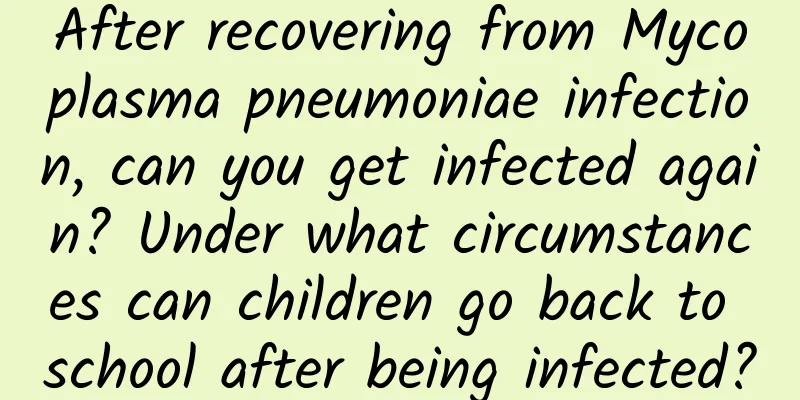After recovering from Mycoplasma pneumoniae infection, can you get infected again? Under what circumstances can children go back to school after being infected?

|
Autumn is the peak season for Mycoplasma pneumoniae infection . "Mycoplasma pneumonia" has attracted much attention recently. Jiang Jiang and Su Su have compiled a list of answers to parents’ questions. Let’s take a look! 1. What is Mycoplasma pneumoniae infection? Is it contagious? Mycoplasma pneumoniae is a microorganism between viruses and bacteria and is a common pathogen in nature. People are generally susceptible to Mycoplasma pneumoniae. The proportion of children aged 5 years and above who develop pneumonia after infection is higher than that of other people. Children under 5 years old and adults can also get sick. This disease is contagious to a certain extent . 2. What are the symptoms after infection? Symptoms in adults after infection are generally mild, with respiratory symptoms such as cough being common, and usually responding well to treatment with antibacterial drugs such as macrolides or quinolones. Because children's immune systems are not yet fully developed, their symptoms after infection with Mycoplasma pneumoniae are more severe than those of adults . They are generally characterized by fever and cough. The cough is more severe and may continue for 1 to 2 weeks after the fever subsides. The course of Mycoplasma pneumonia is related to the severity of the disease, generally 2 to 4 weeks . 3. Can Mycoplasma pneumoniae infection be identified and diagnosed at home? When is the best time to go to the hospital? There is no significant difference between the early symptoms of Mycoplasma pneumoniae infection and other common respiratory pathogen infections. Parents cannot judge on their own whether it is a Mycoplasma pneumoniae infection. Pathogenic testing must be conducted in a medical institution to make a clear diagnosis (when going to a medical institution, be sure to do a good job of respiratory protection and hand hygiene to reduce cross-infection). If a child has a persistent fever, the temperature does not improve or the condition recurs, there is an obvious cough and shortness of breath, or accompanied by wheezing, dyspnea, cyanosis, poor spirits, convulsions, etc., you should seek medical attention in time and receive standardized treatment. Do not blindly use antibiotics on your own . Early diagnosis and early treatment can reduce the risk of severe illness and thus reduce the occurrence of sequelae. 4. Will children who have recovered from Mycoplasma pneumoniae infection become infected again? Children with Mycoplasma pneumoniae infection generally do not suffer from sequelae after recovery, and the possibility of reinfection in the near future is low . 5. How long does it take for a child to go to school after being infected with Mycoplasma pneumonia? It is generally believed that children can return to school after their clinical symptoms have basically disappeared and their physical fitness has basically recovered. It is currently not recommended to conduct pathogen testing on recovered Mycoplasma pneumoniae infected patients. 6. How to prevent it? Mycoplasma pneumoniae is mainly transmitted through respiratory droplets. The pathogen can be carried in sputum, secretions from coughing, sneezing, and runny nose. Patients infected with Mycoplasma pneumoniae and asymptomatic carriers are the main sources of infection. At present, there is no vaccine specifically for the prevention of Mycoplasma pneumoniae infection. The prevention of Mycoplasma pneumoniae infection mainly involves respiratory protection and hand hygiene: wearing masks in crowded places, washing hands frequently, avoiding crowded places as much as possible, and keeping a certain distance from people with colds and coughs. At the same time, pay attention to indoor ventilation, proper nutrition, and ensure that children have outdoor activities and physical exercise time to improve their own resistance. How should schools, parents and students respond? The CDC recommends that schools: 1. Schools should strictly implement the morning and afternoon inspections, registration and reporting of absences due to illness, etc. When students are found to have symptoms such as fever and cough, they should be promptly given masks and their parents should be contacted to take them to see a doctor or go home to rest, and avoid participating in group activities and entering public places. 2. Maintain air circulation in public places such as classrooms, dormitories, and canteens. When weather permits, open windows for ventilation on a daily basis to maintain indoor air circulation; 3. Clean regularly, keep the environment clean, carry out daily disinfection, and provide sufficient hand washing facilities and hygiene products such as hand sanitizer or soap. 4. If there are suspected cases of infection in schools, measures such as symptom monitoring, case management, disinfection, and ventilation should be strengthened. In addition, schools must provide health education on the prevention and control of Mycoplasma pneumoniae for teachers, students and parents. Students do the following: 1. Do not attend classes when you are sick. If you feel unwell, you should report it to your teacher and parents immediately. 2. Maintain good personal hygiene habits, cover your mouth and nose when coughing or sneezing, pay attention to hand hygiene, and try to avoid touching your mouth, eyes and nose with unwashed hands. 3. Eat a balanced diet, maintain a regular schedule, and do moderate exercise to enhance your physical fitness and immunity. 4. During the high-incidence season of the disease, you should try to reduce activities in crowded places, avoid contact with patients with respiratory infections, and wear a mask when necessary. Parents: 1. Pay attention to students' mental state and health. When children have fever, cough or other physical discomfort, they should rest at home and not go to school while sick. 2. Keep the room clean and well ventilated, 2-3 times a day, each time for at least 30 minutes, to keep the indoor air flowing; 3. Help children eat a balanced diet, drink plenty of water, have a regular schedule, exercise moderately, and help and encourage children to develop good hygiene and living habits. In addition, after a child develops respiratory symptoms, pay attention to changes in the condition. If the child has persistent fever, severe cough, or recurring illness, seek medical attention promptly. When family members are caring for the patient or accompanying them to the doctor, they should also wear masks and protect themselves. |
Recommend
Can young girls lose weight by doing fitness?
Girls cannot tolerate being too fat, because obes...
How many kinds of fruit can pregnant women eat in a day
It is essential for pregnant women to eat fresh f...
Can the endometrium thicken on its own?
Endometrial hyperplasia, also known as endometria...
Should you avoid eating mutton, seafood, tofu and other "irritating foods" when you are injured? The answer is surprising
Author: Zhang Yu, Researcher, Institute of Nutrit...
[Medical Q&A] How many types can common childhood mental disorders be roughly divided into?
Author: Zhang Cheng, Beijing Huilongguan Hospital...
Can babies eat shrimp paste? How to make shrimp paste for babies
Shrimp paste is mainly composed of shrimp meat. S...
Why do girls' hemorrhoids itch?
Both men and women may suffer from hemorrhoids, e...
Caesarean section anesthesia needle picture
With the improvement of China's medical techn...
When does the BCG scab fall off? How to tell whether the BCG vaccination is successful?
BCG is a vaccine that the hospital will give to b...
eMarketer: 60% of US mobile phone users frequently use mobile search in 2017
199IT original compilation Search engine usage gi...
Is lotus root starch sweet? What is lotus root starch made of?
Lotus root starch is rich in glucose, carbohydrat...
Will regular breast massage make your breasts bigger?
Many women want to have firm breasts, but Asian w...
Is kale lettuce? Why can lettuce be eaten raw?
Lettuce is a kind of food that is particularly su...
Is it effective to apply a facial mask during menstruation?
Wearing a facial mask is a habit of modern women....
What is the reason for the dull pain in the right lower abdomen during ovulation?
During the ovulation period, you will feel a dull...









